Mercury Transit on May 7, 2003 Mercury's Orbit and Visibility Mercury - the Messenger |  | | Mercury the swift messenger of the ancient gods. |
Mercury was well known to many ancient people who observed it as a bright point of light in the evening or morning sky. Because of its comparatively rapid motion with respect to the stars, the ancient Greeks associated this celestial body with the swift messenger of the gods , and we now use the corresponding name from the Roman mythology, Mercury . This is also the name of the well-known heavy metal that is liquid at room temperature and which is used in thermometers. On this page, we shall look at the orbit of Mercury in the solar system and the visibility of this planet, as it moves around the Sun. You will find more information about the physical properties of Mercury on another page . Mercury's orbit | 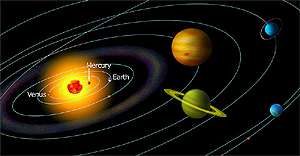 | | Mercury is the innermost planet in the solar system. |
Mercury is the planet closest to the Sun , the innermost of all worlds in the solar system. Mercury revolves around the Sun in an elliptical orbit at a mean distance of 58 million km; the orbital period is 88 Earth days or 0.24 Earth years. Its orbit is inclined about 7° to the plane of the Ecliptic which marks the annual path of the Sun among the stars as seen from the Earth. (The Ecliptic is the projection of the Earth's orbit onto the celestial sphere). Mercury's orbit is very eccentric . When at "perihelion" (the orbital point where a planet is closest to the Sun), Mercury is about 46.0 million km from the Sun and at "aphelion" (the orbital point farthest from the Sun), it is at a distance of 69.8 million km. It is therefore about 1.5 times more distant in aphelion than at perihelion - this is also expressed by the orbital "eccentricity" which is rather large (0.2056). For comparison, the eccentricity of the Earth's much more circular orbit is only 0.0167. Mercury, as the innermost planet, is also the fastest moving major planet in the solar system . The mean orbital velocity is about 48 km/s (the Earth moves at 30 km/s). Mercury's sidereal period is about 88 Earth days - this is the interval of time one body needs to complete one revolution around another body with reference to the stars. The synodic period of Mercury is about 116 Earth days - this is interval of time until Mercury again is in the same position relative to the Sun, as seen from the Earth (the difference is caused by the simultaneous motion of the Earth in its orbit). Both periods are the shortest of any major planet. The mysterious perihelion shift An interesting property of Mercury's orbit is the observed perihelion shift , i.e. that the direction of Mercury's perihelion and aphelion (the " line of apsides ") is progressing slowly along the orbit. This effect is present in all planetary orbits and is mainly caused by the gravitational interaction with the other planets. But it was discovered in the 19th century by means of very accurate positional observations, that the measured rate of Mercury's perihelion shift was different by about 43 arcseconds per century from what the classical (Newtonian) gravitational theory predicted . The origin of this discrepancy was long a great mystery. However, it has since been found that the motion conforms fully with Albert Einstein's General Theory of Relativity - when the "relativistic" terms are introduced, there is absolute agreement between observation and theory. This phenomenon is therefore now completely understood and, in fact, constitutes one of the best proofs of the validity of Einstein's theory. Mercury's visibility Mercury is the planet nearest the Sun and is the most difficult to observe, because it is always quite close to the Sun in the sky. Because of its orbital motion, it appears to swing back and forth around the Sun, reaching a maximum angular distance of about 28°. When Mercury is west of the Sun, it can be seen rather low in the morning sky before sunrise; when it is east of the Sun, it is seen in the evening sky and sets soon after the Sun. When it is high in sky at daytime, Mercury's proximity to the Sun makes it virtually impossible to see it with the unaided eye (and it is of course always dangerous to look in the direction of the Sun!). By far the best time to view Mercury is therefore just before sunrise or just after sunset . Mercury's phases | 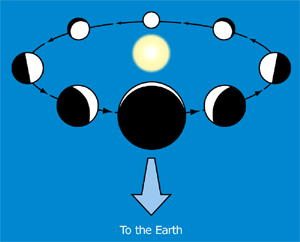 | | Mercury's phases and changing apparent size. |
As all other planets and moons, including our own Moon, Mercury shines by reflected sunlight. Moreover, as the orbit is inside the Earth's, Mercury displays phases which are similar to those of the Moon . The main difference is that, because of the changing distance between the Earth and Mercury, its apparent size changes considerably more than does the Moon's. Seen from the Earth, it is normally not possible to observe Mercury when it is "full" because it is then on the other side of the Sun (in the " superior conjunction ", see below) and located very close to the Sun in the sky. When it is brightest, Mercury appears in the "crescent" phase. When it is nearest to the Earth (at " inferior conjunction " and "new"), Mercury's apparent diameter is almost three times greater than at superior conjunction. This is also the time when Mercury will sometimes pass directly in front of the Sun's disk - an astronomical event referred to as a " Mercury transit ". This happens on May 7, 2003. Configurations | 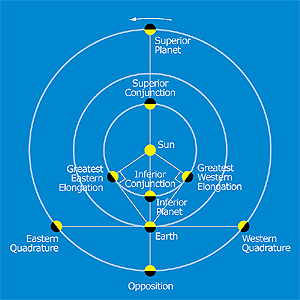 | | The various planetary configurations. |
In order to characterize the positions of a planet in its orbit with respect to the Earth and the Sun, the astronomers often refer to certain positions, called " configurations ". For Mercury and Venus (the " inferior planets ", i.e. which are closer to the Sun than the Earth), the following configurations occur: - the inferior conjunction , when the planet passes between the Sun and the Earth;
- the greatest western elongation , when the planet is to the west of the Sun so that the angle Sun-Earth-planet is as large as possible (about 28° in the case of Mercury and 45° for Venus);
- the superior conjunction , when the planet is on the opposite side of the Sun from the Earth; and
- the greatest eastern elongation , when the planet is as far east of the Sun as possible - the angles are the same as those mentioned above.
For an outer (" superior ") planet like Mars, Jupiter etc., the following configurations occur: - opposition , when the planet is on the opposite side of the Earth from the Sun;
- western quadrature , when the planet is to the west of the Sun and the Sun-Earth-planet angle is exactly 90°;
- conjunction , when the planet is on the opposite side of the Sun from the Earth, and
- eastern quadrature , when the planet is to the east of the Sun and the Sun-Earth-planet angle is again 90°.
When do transit events occur? | 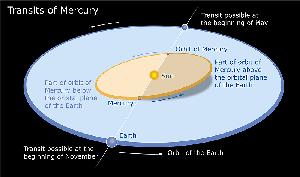 | | Orbits of Mercury and the Earth around the Sun. |
When Mercury is at inferior conjunction (this happens on the average once every 116 days - the synodic period, see above) and at the same time is close to one of the orbital nodes (the points of intersection between the Mercury orbit and the Ecliptic), it will pass in front of ("transit") the solar disk, as seen from the Earth. Mercury's orbital plane is inclined by an angle of 7° to the plane of the Ecliptic and the two conditions - that Mercury is simultaneously at inferior conjunction and at an orbital node - are not always fulfilled. Mercury transits are therefore fairly rare celestial events . On the average, there are 13 Mercury transits each century , i.e. about one every 7 1/2 years. However, they do not occur at regular intervals, but in succession at intervals of 13, 7, 10 and 3 years. Each year, the Earth passes Mercury's line of nodes around May 7 and November 9. Mercury transits can therefore only happen around these dates. This year, a transit takes place on May 7, 2003 , and the next events occur on November 8, 2006 and May 9, 2016 . Mercury transits do not all last equally long. The time it takes Mercury to move across the solar disk varies - it depends on the momentary velocity of the planet in its orbit and, in particular, on the exact path across the Sun's face. A Mercury transit may last up to 9 hours. The most recent Mercury transit happened in 1999 but it was not visible from Europe. The Four Contacts The main events occurring during a transit are conveniently referred to as " contacts ", entirely analogous to the contacts of an annular solar eclipse: - the First Contact is the beginning of the transit, when the closest point of the planet's disk for the first time "touches" the solar limb. It is always difficult to say exactly when this happens, but soon after this moment, the planet can be perceived as a small dark notch in this limb.
- the Second Contact is the moment when the dark disk completely crosses the solar limb and is from now on now seen in its entity in front of the Sun. During the next hours, the silhouetted planet slowly traverses the brilliant solar disk. At
- the Third Contact , the planet first "touches" the opposite solar limb and the transit event ends at
- the Fourth Contact , when the planetary disk finally "leaves" the Sun completely.
An Earth transit | 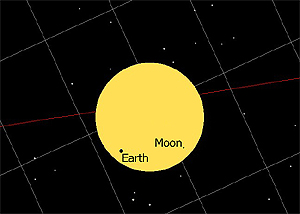 | | Earth and Moon transiting the solar disk, as seen from Mars, on 11 May 1984 (Earth time). |
No transits of the outer planets can obviously be observed from the Earth. However, solar transits of the Earth (as well as of any other planet nearer the Sun) may be observed from the surface of the outer planets. For example, on 11 May 1984, the Earth could be observed from Mars in transit across the solar disk . It took about 8 hours for our planet to move across the face of the Sun and the Earth's Moon followed about 6 hours behind. Thus, for a while both the Earth and the Moon were visible as moving black dots on the surface of the Sun - that is, if you had been observing from Mars! |
|
|
| | |